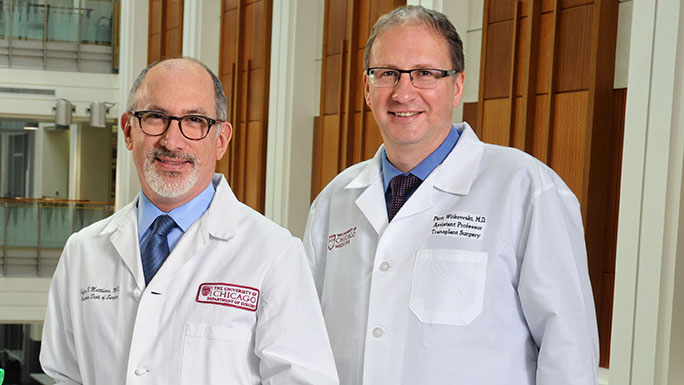Total Pancreatectomy with Islet Autotransplantation (TP-IAT)
Total pancreatectomy with islet autotransplantation has emerged as a surgical option for treating patients with debilitating pain from chronic pancreatitis. It may also be an option for patients with recurrent acute pancreatitis, who experience multiple hospitalizations that affect their quality of life, including their ability to work or go to school.

About 70 percent of patients experience dramatic pain relief after total pancreatectomy (TP) with autologous islet cell transplantation (IAT). Approximately 30 to 40 percent of patients who have IAT will not require insulin injections after the procedure. Other patients may need to take daily insulin and monitor their blood glucose closely, but the severity of their diabetes is less compared to patients who did not undergo IAT.
The University of Chicago Medicine is one of a few U.S. hospitals to offer autologous islet cell transplantation after total pancreatectomy. The goal is to prevent the onset of diabetes or reduce the severity of the disease.
Breakthrough Pancreatic Research & Clinical Trials
As a top research institution, UChicago Medicine offers qualified patients the unique opportunity to advance biomedical innovation by participating in structured clinical studies. Our physicians currently are examining the safety and efficacy of a drug aimed at reducing the risk of diabetes development in patients undergoing total pancreatectomy with islet autotransplantation for chronic pancreatitis.
Find out if you are eligible to participate in a clinical trial
Frequently Asked Questions
A total pancreatectomy is the removal of the entire pancreas. Pancreatectomy can be used to treat severe forms of pancreatitis or pancreatic cancer. Most people who have had total pancreatectomy and autologous islet cell transplantation for pancreatitis find a dramatic improvement in their abdominal pain. The use of narcotic pain medicine is eliminated in 70 percent of patients.
Autologous islet cell transplantation (IAT) is a procedure that is performed to prevent diabetes or reduce the severity of diabetes after removal of the pancreas (pancreatic resection). After pancreatic tissue is removed during surgery, insulin-producing islet cells are immediately isolated from the pancreas in a lab. These islet cells are then transplanted into the patient's liver through a major blood vessel called the portal vein. The islet cells continue to produce insulin to control blood sugar levels in the body.
Other names for autologous islet cell transplantation include:
- Autotransplantation of islet cells
- Autoislet transplantation
- Islet autotransplantation
The pancreas is a large gland located behind the stomach. One of the key duties of the pancreas is to produce the hormones insulin and glugagon to metabolize sugars (glucose) in the blood. The cells in the pancreas that produce these hormones are called islet cells. Insulin is needed by the body to convert blood sugars into energy. Without insulin, there is a build-up of sugar in the blood. Diabetes occurs when the body does not produce enough insulin, leading to an increased glucose level in the blood. Most patients experience dramatic pain relief after total pancreatectomy with IAT.
When the pancreas is removed, the body loses its ability to produce insulin, so diabetes will occur. Typically, the form of diabetes that occurs after pancreas resection — known as brittle diabetes — is very severe and difficult to control. Managing it may require frequent glucose monitoring and insulin administration. Moreover, brittle diabetes can lead to hypoglycemia episodes, heart and kidney disease, vision problems, poor circulation, foot conditions and/or neuropathy. Some of these complications can be life-threatening.
Physicians can prevent or reduce the effects of diabetes after pancreas removal by performing autologous islet cell transplantation. Benefits of autologous islet cell transplantation include:
- Approximately 30 to 40 percent of patients who have IAT will not require insulin treatment after the first year or two. For the 60 percent of people who do require insulin, their diabetes is typically much more easily managed.
- In people who already have diabetes, IAT decreases the chance for the development of very difficult-to-control brittle diabetes
- Prevention or reduced risk for the development of diabetes in patients who did not have it before
Because the islet cells used in this procedure belong to the patient, there is no risk for immune reactions.
Benefits of IAT
Although IAT has been performed for more than 25 years, there is only limited data on long-term results for patients who have had the procedure. Current information suggests that there is a slow, steady decline of transplanted islet function over many years after the procedure, but that significant and beneficial islet function persists for 10 years and even longer after the original operation. This experience should be balanced against the observation that as many as 50 to 80 percent of patients with chronic pancreatitis may develop diabetes within years, regardless of medical and surgical therapy.
Each case is different, and multiple factors affect the level of insulin independence a patient will experience. Studies show that these factors include the following:
- The condition of the pancreas at the time of the procedure, including the type of prior operations that may have been carried out. These factors affect the amount of islet cells that can be transplanted. A certain amount of healthy islet cells are required.
- The overall health of the patient and presence of other diseases that may affect outcome
- The patient's body mass index (BMI); people with a BMI below 30 have a greater chance of not needing insulin
People who are candidates for autologous islet cell transplantation include:
- Patients with debilitating pain from chronic pancreatitis
- Patients who experience multiple episodes of acute pancreatitis (particularly those with underlying genetic conditions) and other treatment options are unsuccessful
Autologous means that patients are receiving their own tissue for transplant. Allogeneic refers to the transplantation of tissue from one person to another.
Allogeneic islet transplantation is not used to prevent Type 1 diabetes — it is used to treat it when is it already present. It is being studied as an alternative to whole-organ pancreas transplant for people with severe diabetes. In this procedure, islet cells are taken from a cadaver pancreas and then isolated and transplanted through the portal vein into the patient's liver. There is no surgery required. Because the islet cells came from a donor organ, the patient will require immunosuppressive therapy after treatment.
Learn more about allogeneic islet cell transplantation
UChicago Medicine is one of the select few hospitals in the nation that is performing both autologous and allogeneic islet cell transplantation.
Patient Resources
Patient Information
Your care and well-being are our primary concerns, and we want your stay to be as comfortable as possible.
See all patient resourcesSecond Opinions
Seeking the opinion of an expert can ease your mind and help you feel more secure in the medical decisions you are making.
Request a second opinionU.S. News & World Report Rankings
We continue to place highly in categories in the U.S. News & World Report annual rankings. See our full list of ranked specialties.
U.S. News & World Report RankingsClinical Trials
Our research gives our patients access to new treatments and therapies.
View all clinical trialsDirections & Parking
Step-by-step instructions on how to get to our main campus by car and public transportation.
Get directionsClasses & Events
We offer relevant classes, screenings and support groups to help you lead a healthier life.
See all classes and eventsUnderstanding Chronic Pancreatitis

